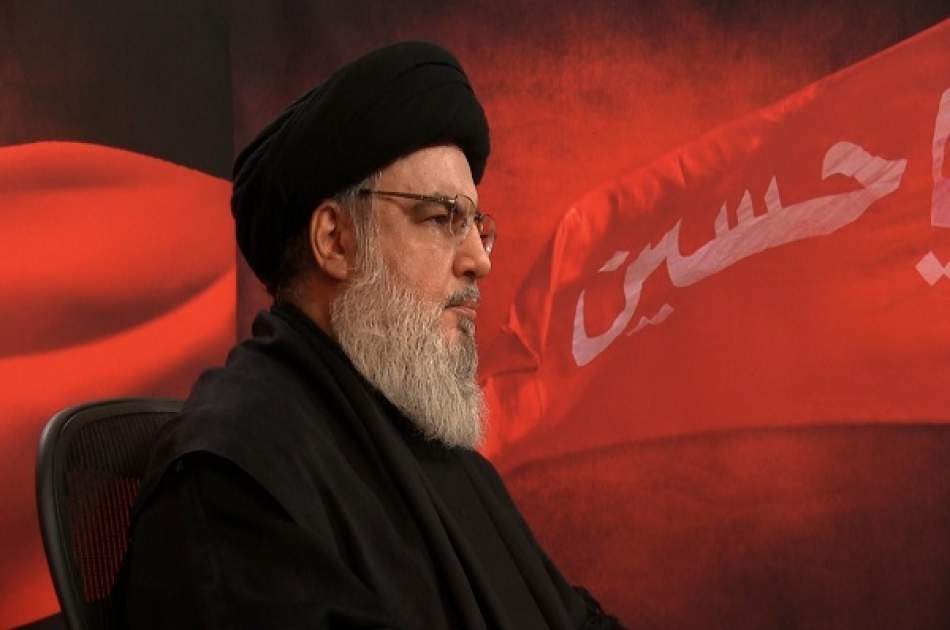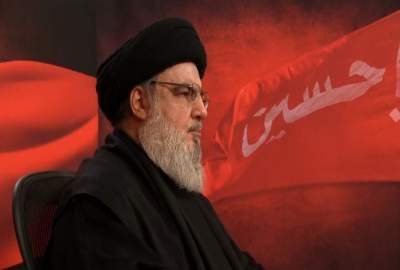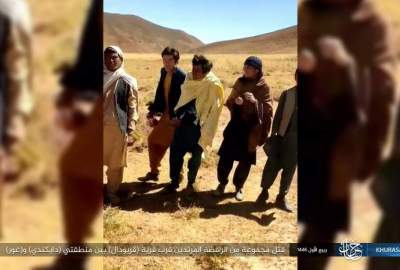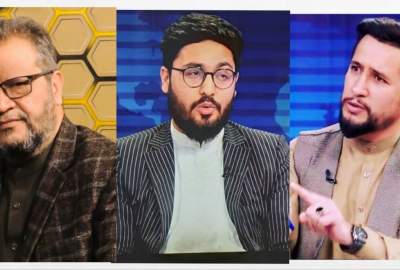On Friday (Sept 27) evening, the war planes of the Zionist regime bombarded the residential areas of Hareh Harik area in the suburbs of Beirut. A few hours ago, Hezbollah of Lebanon issued a statement confirming the martyrdom of Seyed Hassan Nasrallah, the secretary general of this movement, in the attack of the Zionist regime on the southern suburbs of Beirut.
Publish dateSaturday 28 September 2024 - 17:30
Story Code : 297532
Afghan Voice Agency (AVA): On Friday evening (Sept 27, 2024), the Zionist regime announced with a brutal and unprecedented attack on the southern suburbs of Beirut that the target of this attack was the headquarters of Hezbollah. The regime announced this Saturday morning that it assassinated Seyed Hassan Nasrallah, the Secretary General of Hezbollah in Lebanon, in an air attack on Beirut, the capital of Lebanon.
Some sources of the Zionist regime announced that in the attack on the southern suburbs of Beirut, 8 to 12 fighters were carried out at the same time, and 2,000 pounds of American mortar bombs were used.
It should be noted that since about 12 months ago (October 7/October 15) in response to the Zionist regime's genocidal war in Gaza, Lebanon's Hezbollah started attacking the positions of the Zionist regime and announced that it would support the Palestinians until the war ends.
Who was Seyyed Hassan Nasrallah?
Seyyed Hassan Nasrallah was one of Lebanon's contemporary combative and mujahid clerics and the general secretary of the Hezbollah movement in this country, who stood against the aggressions and crimes of the Zionist usurping regime and defended the oppressed Palestinian nation.
The
education
Seyyed Hassan Nasrallah was born on August 31, 1960 in the village of "Albzourieh" in southern Lebanon. As a teenager, he went to Najaf in 1976 and began his seminary studies there. Seyyed Hassan returned to Lebanon in 1978 and pursued his seminary studies at Imam al-Mantazhar (a.s.) school, which was founded by martyr Seyyed Abbas Mousavi, and at the same time, he engaged in political activities in the Amal movement in the Bekaa region. .
Secretary General of Lebanon's Hezbollah
In 1992, after the martyrdom of Seyed Abbas Mousavi, the then Secretary General of Hezbollah in Lebanon, Seyed Hassan Nasrallah was recognized as the new Secretary General of this movement by the consensus of the Hezbollah Leadership Council.
The martyrdom of Seyed Abbas Mousavi along with his family had a great impact on the spirit of the Lebanese people, especially the Hezbollah fighters, and it was after that that Hezbollah's campaigns and attacks took a new form and the general support for Hezbollah among the Lebanese people increased.
Meanwhile, in 1993 and 1996, "Israel" carried out the "Clusters of Anger" and "Settlement" operations, which faced the stubborn resistance of Hezbollah, which had the least military facilities.
The
In September 1997, two Hezbollah fighters were martyred in an attack on one of the positions of the Israeli army in the Jabal al-Rafia region in southern Lebanon, and their bodies fell into the hands of Israeli forces. Without knowing the identity of these two people, the Israeli regime television showed their bloodied picture, it was quickly revealed that one of these two people is Seyed Hadi, the son of Seyed Hassan Nasrallah, the Secretary General of Hezbollah. The publication of this news sounded like a bomb in the Lebanese society and resulted in a very important change. In the history of Lebanon, either during the civil war or in the face of Israel's military aggression, it has never been seen that the son of one of the leaders of political factions or militias was killed in the struggle.
This incident caused a wave of feelings of sympathy, respect and admiration for the Secretary General of Hezbollah among all the religious communities of Lebanon, so that all the members of the Lebanese nation of every religion were deeply affected by this incident. Lebanese political leaders also visited Sayyed Hassan Nasrullah one after another and congratulated and congratulated Sayyid Hadi on the martyrdom of Hezbollah's militant and Sadegh, and expressed their gratitude and respect.
The
Victory over the Zionist regime
In the year 2000, when the negotiations between Yasser Arafat and the American and Israeli officials to resolve the Middle East conflict did not lead to a solution, the Zionist army withdrew from the occupied territories of southern Lebanon in a unilateral move and without taking the slightest concession from Hezbollah. The limited areas of Shabaa farms withdrew their forces from all the occupied areas.
This disgraceful defeat, in addition to strengthening Hezbollah's position based on resistance, made Sayyed Hassan Nasrallah achieve an unprecedented success among the Arabs, until he was recognized as the most important figure in the Arab world.
On the other hand, based on this success, the Lebanese Hezbollah was able to strengthen its presence in the political arena of Lebanon, to the point where, in addition to its large presence in the Lebanese Parliament, it also took the helm of a number of ministries.
The
The lessons of Palestinian intifada from Lebanon's Hezbollah
Successive victories of Hezbollah in various political and military fields also left an impact among the Palestinians. The displaced Palestinian people, especially the young people, who had closed their hearts to the Middle East peace negotiations process for years, realized that the Palestinian problem cannot be solved by negotiating with the occupying regime, and with this background, the second Al-Aqsa Mosque intifada was formed; The intifada that gave Hamas another power and entered a new stage with the victory of Hamas in the Palestinian elections; A stage that will not end with the six-day war between the Arabs and Israel, as Seyyed Hassan Nasrallah said in his message: "From now on, you wanted a full-scale war, so this is your full-scale war." Your government wanted the rules of the game to change, so the rules of the game will change. You don't know who you are fighting today. You entered with the children of Muhammad (peace and blessings of Allah be upon him), Ali, Hasan and Hussein (AS) and with the family of the Messenger of God (PBUH) and his companions.
You are fighting against a nation that has a faith beyond and superior to all humans on this planet. You demanded a full-scale war with a nation that is proud of its history and culture and has material power, facilities, skills, wisdom, calmness, determination, stability and courage, and with the hope and help of God, we will see the coming days between us and you."
You are fighting against a nation that has a faith beyond and superior to all humans on this planet. You demanded a full-scale war with a nation that is proud of its history and culture and has material power, facilities, skills, wisdom, calmness, determination, stability and courage, and with the hope and help of God, we will see the coming days between us and you."
The
The life of Seyyed Hassan Nasrallah in his childhood
Due to the economic pressures in southern Lebanon, he migrated to Beirut with his family and settled in the outskirts of the capital in the Quarantine neighborhood.
He himself mentioned that when he was a child, he used to wrap his grandmother's long black shawl around his head and tell the audience that I am a cleric, pray behind me. Seyyed Hasan Nasrallah's character was formed in Carantina neighborhood.
As a teenager, he worked with his father in a fruit shop. Seyyed Hassan Nasrallah, unlike his friends who always went to the football fields and tourist beaches of Beirut, went to the nearby areas of Quarantine, Al-Nabaa, San El-Fiel and Burj Hammoud to use the spiritual atmosphere of their mosques.
The
Since his childhood, he was very interested in studying and has done many studies in the field of religion. He completed his primary education in Koi Al-Najah and San El-Fiel schools, and at the same time as the civil wars in Lebanon, he returned to his hometown Bazourieh with his family and finished high school in the city of Tire.
Marxist and communist leftist movements were very active in Al-Bazurieh at that time, but he joined the Amal Islamic movement that Imam Musa Sadr had founded in Lebanon. It didn't take long for Seyyed Hasan to expand his political activity as Amal's representative in Al-Bazurieh.
He met a religious teacher named Seyyed Mohammad Al-Gharavi in the Sadr Mosque in the city of Soor, and with his help, he went to Najaf to continue his seminary studies. There, Seyyed Hassan Nasrallah contacted Ayatollah Seyyed Mohammad Baqer Sadr, but he was introduced to a person named Seyed Abbas Mousavi, and in his first meeting with Mousavi, he tried to avoid the Lebanese accent and began speaking fluent Arabic.
Seyyed Hassan Nasrallah continued his studies in Najaf under Mousavi and Ayatollah Sadr and completed his studies in 1978. During this period, political and security changes had spread in Iraq. In these developments, students of religious studies in Najaf were always wanted. During this period, the Lebanese students also faced various accusations, including cooperation with the Iraqi Party of Dawah, cooperation with the Amal movement in Lebanon, or association with the ruling Baath party in Syria.
Due to the pressures in Iraq, he returned to Lebanon and studied and taught at Baalbek seminary. Beside seminary education, Seyyed Hassan Nasrallah did not neglect military training and went through various guerilla courses. Seyyed Hasan was appointed as the representative of the Amal movement in the Bekaa valley due to his ability to manage and command.
How was Hezbollah formed?
In 1982, with the beginning of the occupation of Lebanon, the Amal movement was divided into 2 currents, the first current, led by Nabih Berri, wanted the forces of the movement to be placed next to the National Salvation Front, and the second current, led by Seyed Abbas Mousavi and Seyed Hassan Nasrallah.
The most important reason for the Shia forces not joining the forces of the National Salvation Front was the existence of a personality like Bashir Jameel. Because Bashir Jamil was looking for the presidency of Lebanon along with his relations with Israel.
avapress.net/vdchxqnii23nwmd.01t2.html
Top hits







